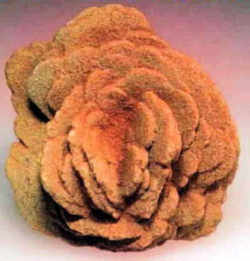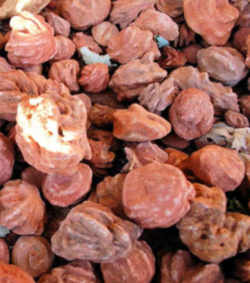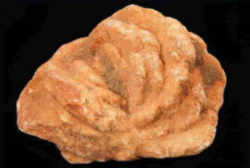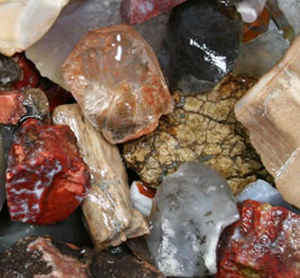
Oklahoma Symbols
Oklahoma State Rock
Barite Rock aka Rose Rock

(Barite rose)
Adopted on April 8, 1968.
The barite rosette or "rose rock" has been the state rock of Oklahoma since House Bill 1277 was approved by the Oklahoma legislature on April 8, 1968, and was signed into law by Gov. Dewey F. Bartlett. Rose rocks are found in central Oklahoma, although barite deposits also occur in the Wichita and Ouachita mountains. Similar rosettes occur in Kansas, California, and Egypt. The rose rock is an aggregate of barite and sand formed like a fully bloomed rose, with five to twenty radiating plates or blades that appear as the petals.
In the 1960s rock and mineral collectors campaigned for the barite rosette to become Oklahoma's state rock. Their petition drive resulted in a bill proposed in the state House of Representatives and subsequently enacted in 1968. Always attractive to rock hounds, rose rocks thereafter became very popular and marketable in tourist venues. The Rose Rock Museum, established at Noble, Oklahoma, in 1986, showcases original art work that includes rose rocks. A Rose Rock Festival has been annually held at Noble.
Oklahoma State Rock: Barite Rock aka Rose Rock

Sometimes called the "barite rose" or "sand barite rosette." Rocks resembling full-grown roses were formed by barite rock crystals during the Permian Age (250 million years ago) when ocean waters covered the western half of Oklahoma, and the counties of central Oklahoma were under shallow bays. Over time, barite (barium sulphate, BaSO4) precipitated out of sea water and crystallized around grains of quartz sand. Over eons, the ocean retreated westward, and a geologic formation of reddish sandstone, locally called the Garber sandstone, was left in a broad band across central Oklahoma. In Oklahoma, the distinctive red soil colors them in hues ranging from reddish brown to cinnamon.
An old Cherokee legend says the rocks represent the blood of the braves and the tears of the maidens who made the devastating "Trail of Tears" journey in the 1800s to Oklahoma.
They have been reported in small quantities in California, Kansas, and Egypt, but are in greatest concentration in the Permian Garber Sandstone in a narrow belt that extends 80 miles through the central part of Oklahoma between Pauls Valley and Guthrie. The most abundant and well-formed specimens are found in an area just east of Norman, near Noble, also known as the "Rose Rock Capital of the World".
The cluster, found 20 miles southeast of Norman, Oklahoma, is 62 inches long, 24 inches high and 18 inches wide. It weighs 788 pounds and required three months to extract intact. Named "Redwine and Rose" for its finders, Tom and Ann Redwine, the final removal and cleaning of the specimen took the efforts of four men over a two-day period.
BARITE PHYSICAL CHARACTERISTICS:

Barite is a common mineral and makes very attractive specimens. It often is an accessory mineral to other minerals and can make a nice backdrop to brightly colored crystals. At times bladed or tabular crystals of Barite form a concentric pattern of increasingly larger crystals outward. This has the appearance of a flower and when colored red by iron stains, these formations are called "Desert Roses".
- Color is variable but is commonly found colorless or white, also blue, green, yellow and red shades.
- Luster is vitreous.
- Transparency crystals are transparent to translucent.
- Crystal System is orthorhombic; 2/m 2/m 2/m
- Crystal Habits include the bladed crystals that are dominated by two large pinacoid faces top and bottom and small prism faces forming a jutting angle on every side. There are many variations of these faces but the flattened blades and tabular crystals are the most common. If the pinacoid faces become diminished or are absent, the resulting prismatic crystal has a rhombic cross section. Also scaly, lamellar, and even fiberous.
- Cleavage is perfect in one direction, less so in another direction.
- Fracture is conchoidal.
- Hardness is 3 - 3.5
- Specific Gravity is approximately 4.5 (heavy for translucent minerals)
- Streak is white.
- Associated Minerals are numerous but significant associations have been with chalcopyrite, calcite, aragonite, sulfur, pyrite, quartz, vanadinite, cerussite and fluorite among many others.
- Other Characteristics: green color in flame test (see above).
- Notable Occurrences include Oklahoma, Connecticut and Colorado, USA; England and Germany.
- Best Field Indicators are crystal habit, flame test and density.
Oklahoma House Bill No. 1277
An Act designating the Barite Rose as the official State rock; directing codification; and declaring an emergency.
Be it enacted by the People of the State of Oklahoma:
SECTION 1. State rock
The Barite Rock, commonly know and referred to as the "rose rock", is hereby designated as the official rock of this State.
SECTION 2. Codification
Section 1 of this Act shall be inserted in the Oklahoma Statutes as Section 98.1 of Title 25.
Approved April 8, 1968. Emergency.
Minerals, & Gems

Gemstone, Minerals, Rocks






